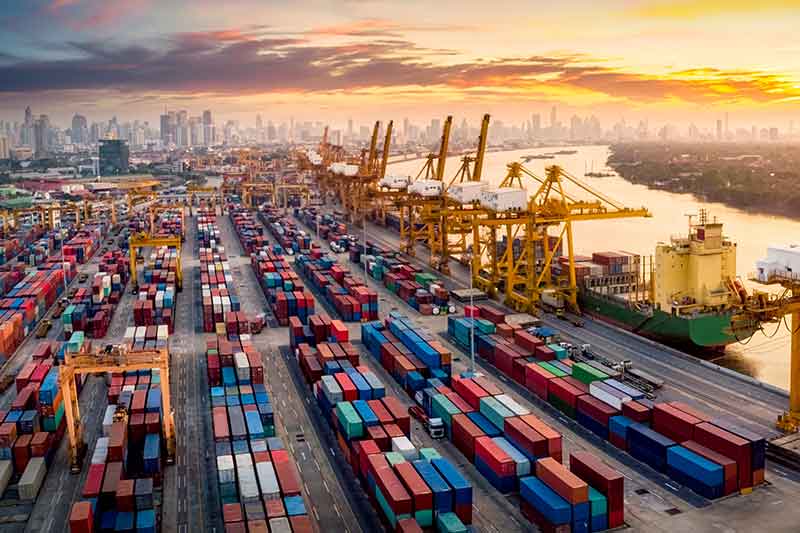Category: Shipping
5 Green Trends That Will Transform The Logistics Industry
The shipping industry has existed for centuries and its equipment and technologies have certainly become increasingly sophisticated and efficient. Traditional shipping procedures, however, have contributed to approximately 3-4 percent of global emissions. In this post, you will learn more about several green trends that are transforming the logistics industry for the better.
Optimization of Port Management Procedures
More shipping companies in the logistics industry are expected to refine and optimize their port management procedures. For example, research has shown that companies are progressively shortening the amount of time that ships typically spend idling in docks and harbors. This practice has helped improve turnaround time, reduce carbon dioxide emissions, and have simply made shipping processes significantly more efficient than before. The good news is that these practices have been adopted by almost all major shipping companies. This means that the logistics industry will become increasingly greener.
The Use of Sky Sails
Sky sails are a relatively new invention and are ingeniously simple. They involve using large kites to tow a cargo ship during its voyage. Because sky sails utilize the limitless energy of wind power, they can take significant strain off a ship’s engine. All in all, this green technology increases propulsion efficiency, cuts emissions, and lowers fuel expenditure. Shipping companies will have no issues adopting this technology because the cost of implementing it is minimal.
The Rise of Voyage Optimization
Modern-day technologies are making voyages less unpredictable and far safer than ever before. They allow shipping companies to predict the weather and other maritime conditions with great accuracy. That’s not all; shipping companies across the globe are also using these technologies to monitor and/or predict the performance of their ships in various sea conditions. The data allows them to make more informed decisions about which routes to take. In addition to avoiding high winds and rough seas, voyage optimization is also a great way to reduce fuel consumption and one’s carbon footprint.
Increased Slow Steaming Practices
In order to reduce fuel consumption on a voyage, some shipping companies also rely on slow steaming techniques. This method often involves companies running their ships at a lower speed. Slow steaming began as a way for companies to cut costs but in 2010, nearly all global shipping companies incorporated it into their Standard Operating Procedures. Today, it has become one of the most important green trends in the shipping industry. It is now a highly effective and simple way of reducing carbon emissions.
Cutting Carbon Fuel Consumption
While reducing fuel consumption can help slash carbon emissions, one has to consider the scale of the shipping industry. This means that more has to be done if global shipping companies were to reduce their environmental impact significantly. Fortunately, a promising new technology is emerging: low-carbon fuels. They are designed to reduce greenhouse and noxious gases that can be emitted by large cargo ships. By stripping away larger quantities of impurities such as sulfur and ash, these fuels tend to have a lesser toxicity effect on human health and the environment.
As you can see, green shipping practices have already started to revolutionize the shipping industry. All of them are essential for combating the negative effects that fossil fuels have on the global climate.
What a Successful Retail Procurement Team Looks Like
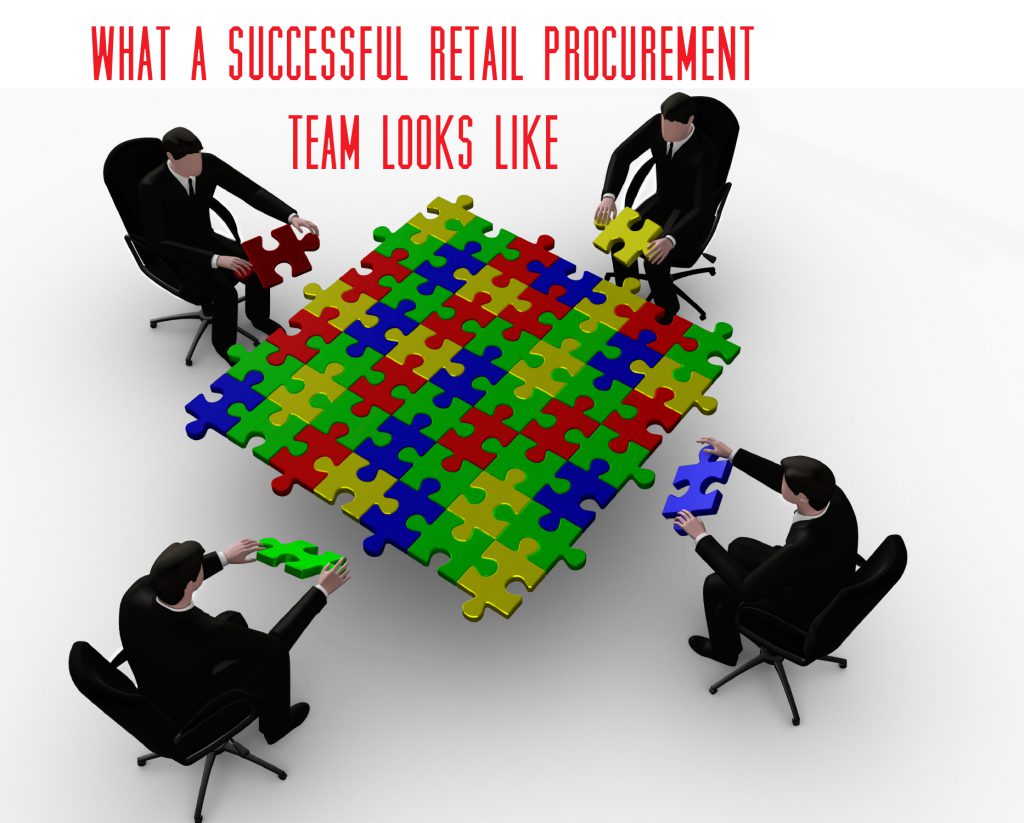
Continuously finding ways to improve and run a business more efficiently doesn’t apply only to those in manufacturing or logistics. Retail companies need to consistently look for more ways to innovate how they procure and work with suppliers, in addition to keeping stores full of the items customers want the most.
Optimizing expenditures, both direct and indirect, can help retailers reduce costs and improve services offered by suppliers.
The successful procurement team and their habits
- Support company strategy – The leadership team works to create a strategy that can be followed by everyone in the company, from the CEO to the newest employee. A great procurement team will use that strategy to drive decisions and support the organization. Pushing the strategy forward unifies the procurement team and the entire company.
- Implement continuous improvement strategies – No strategy is worth following if it doesn’t somehow emphasize continuous improvement. The procurement team should work toward improving the quality of products while reducing costs. It’s that simple.
- Ensure better service – Procurement teams can improve quality and cut costs, even if the products themselves continue to be more expensive, by negotiating for improvements in services offered by the supplier. As the cost of goods increases, prices for the consumer can be maintained if services such as shipment tracking work efficiently or if the goods consistently reach store shelves without damage. Often procurement teams can find room for improvement in last-mile deliveries. Suppliers help the retail company reduce costs and customers benefit from better prices.
- Test the market – As much as relationships matter, a great procurement won’t simply accept that their current supplier is the best for the business. Consistently researching vendors and making changes if necessary is crucial to an efficient procurement organization. A supplier that just didn’t fit a few years ago may be the best for the business today. Staying on top of development within the industry and supplier infrastructure enhancements can make a big difference. It’s up the procurement team to stay on top of changes with suppliers. We all know the business world moves fast and procurement teams need to be nimble and ready for change when an opportunity presents itself.
Keeping the customer first
Sitting in an office and constantly working to improve the bottom line can make it all too easy to forget what matters most to a retail business – the customer. Hopefully, the company strategy focuses everyone on the customer, but if not, it is essential for procurement teams to base decisions on how they will affect the end customer. If changing the way products are delivered to stores only helps the team working from the corporate office and not the folks working at the store, you could be damaging customer relationships or product availability.
A few pennies saved from the bottom line won’t matter if the change drives customers away. Great procurement teams can see the effect of changes all the way through the supply chain and into the store. The customer is still king – that much about business hasn’t changed.
Working with a 3PL Provider
Successful procurement teams work with logistics management providers who implement the latest technology and offer services that are a complete turnkey solution. The latest technology supplies your procurement department with the vital information needed when organizing build outs or remodels, whether for one store or hundreds.
STC Logistics will work directly with your procurement department or with your individual vendors. As a complete turnkey solution, in addition to our direct logistic management and supply chain management services, we also provide white glove service, sort & segregate fulfillment and installation services nationwide. To learn more about our 3PL retail logistics services and expedited shipping, click below!
Common Retail Industry Warehousing Issues and How to Solve Them
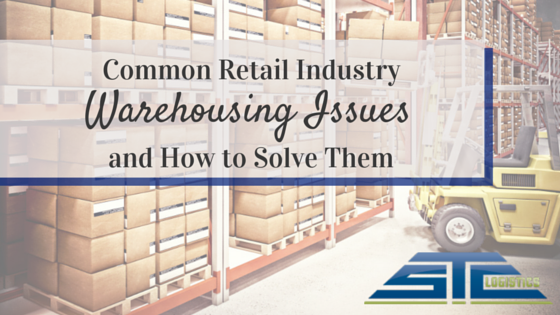
Warehouses are commonly used by retail businesses to store items that have been shipped to them but have not yet been moved into stores. In addition to retailers, transport businesses, manufacturers, customs, importers and exporters use warehouses as well. They may be designed to house goods of a certain type; perishable goods, for instance, are stored in refrigerated warehouses. They may be used to assemble containers for export or prepare consolidated shipments for distributions.
Despite the tremendous value warehouses provide for companies, some issues cannot be avoided altogether. In this article, we will look at some of the most pressing retail warehousing issues and how they may be solved, avoided or minimized.
Top Retail Warehousing Issues
1) Not having enough space
The amount of storage space needed for a company depends on the size and quantity of goods to be stored and length of time which storage is required. Companies aim to rent or purchase warehouses that have enough space to meet their needs, but sometimes end up ordering more merchandise than their space can accommodate or under estimating the length of time necessary. More often, the issue of space occurs as a consequence of inadequate organizational practices, such as not making efficient use of the available space or experiencing delays in implementation of goods at final destinations. Such poor organization leads to time and money being wasted on unnecessary labor and square footage.
To ensure adequate warehouse organization, a company should contract with warehouses and 3pl companies that understand the parameters of retail warehousing requirements. This way, less time will be spent locating items and in turn expedite the actual shipping process, such as using expedited logistics services. The machines used in loading and unloading should also be taken into consideration since they, too, are typically stored on-site. Counter balance machines are not very good for retail warehousing and should be rejected in favor of narrow aisle reach trucks and multi-directional forklifts, which can increase storage space by thirty and forty percent respectively.
Another important element of space management in retail warehousing is to have the place thoroughly evaluated by a professional forklift business. This can further maximize storage space. It is essential to have a facility that understands retail needs and can provide flexibility.
2) Slotting
When looking for slots to store items that have just arrived, forklift trucks often make one trip after another while scouring for space around the warehouse, wasting gas or electricity. As a result, they often end up putting their loads into the first empty slot across which they come, again resulting in disorganization. The last thing that any retail business needs or wants is disorder; they need to know exactly where something is so their customers will not have to wait for inventories to be replenished or for new products to launch.
There are numerous types of storage racks, and good retail warehouse practices involve knowing what they are and the purposes for which they may be used; these include:
- cantilever
- double deep
- drive-in
- powered mobile
Companies can also plan the use of slots, taking into account special needs for certain items as well as supply needs.
3) Discrepancies in inventory, not picking fast enough
Another common warehousing problem occurs when too much time is spent on each item because of poor management practices. When scanned mechanically, barcodes can reduce handling time for merchandise, providing order and ease of access. For larger items and fixture or displays, pallets can be color coded in order to group together specific store configurations or marketing campaigns, thus allowing design teams to have easy access.
In conclusion, retail freight logistics and retail warehousing depends, more than anything else, on organization. With everything in its proper place and employing proper accounting and moving machines, retail warehousing can be vastly simplified, to everyone’s great satisfaction.
STC Logistics specializes in nationwide retail logistics solutions and warehousing services. We ensure not only that your items arrive on time and undamaged with our expedited logistics services, but are stored safely and scheduled with cost-efficiency and reliability. To learn more about our retail freight logistics solutions, click below.
Expedited Logistics: Four Benefits of Working with a 3PL Provider
Expedited logistics are required for many reasons—especially with retail logistics and pharmaceutical logistics—primarily for ensuring that a product launch is made on time, that products are available at a manufacturing site or that a time-sensitive shipment gets to a customer quickly and undamaged. Expedited logistics have played a major role in the economy and throughout the supply chain process to meet time-sensitive deadlines while still upholding the quality that the client requires. These fast freight shipping services are typically carried out through air freight preferences – although, a savvy 3PL provider may be able to provide ground and ocean options, depending on the transit times, weather forecasts and other factors.
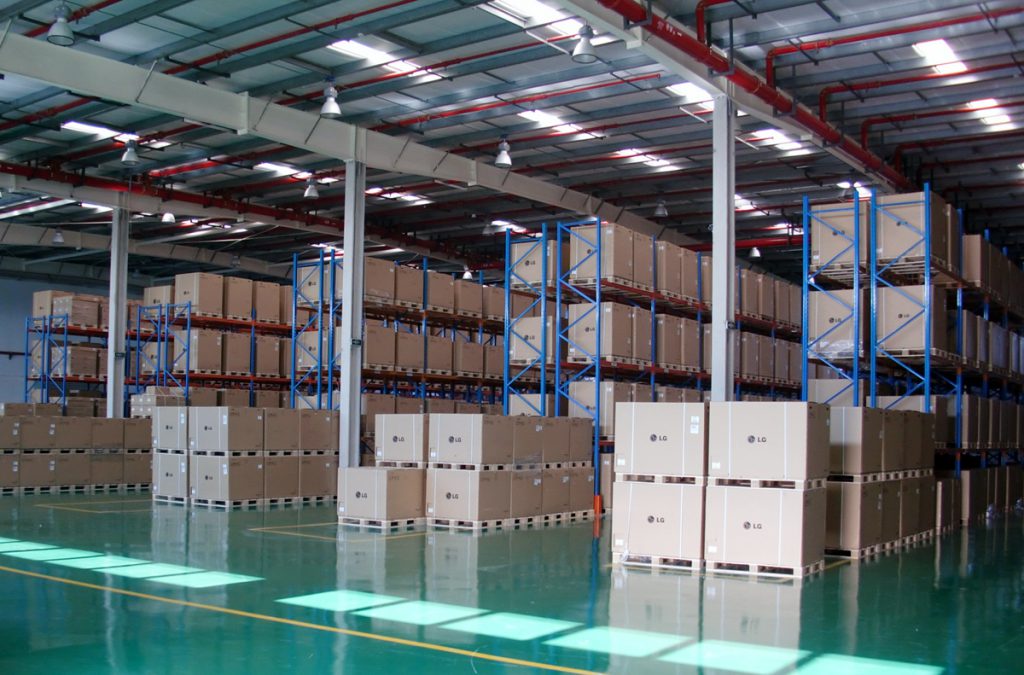
Determining the Best Schedule
When a business decides to work with a 3PL for expedited logistics, they’re able to attend to their own schedule without being hindered by an extremely regimented shipping routine. The 3PL can determine the most direct shipping schedule for reliable logistics, leaving the business to only worry about their customers’ needs.
Additionally, customers often appreciate being given several options for freight shipping, such as same day, next day, weekend and 3-5 day services. Small businesses can gain more favor with their clients if they are able to meet last-minute deadlines which expedited logistics allow them to.
Customer Choice & Satisfaction
One of the main reasons 3PL offersexpedited logistics is that it gives the customer a choice. If they are missing critical fixtures from a time-sensitive campaign or have received the wrong equipment, they can have peace of mind that an expedited service will help them resolve the issue. While this service is available for an increased cost, the benefits far outweigh any risks. Using a 3PL for expedited logistics gives a business the ability to make an informed choice for their most demanding needs.
Another equally important reason to have expedited logistics is customer satisfaction. When a customer is in jeopardy of missing a launch or needs help, demonstrating the flexibility of providing on-time delivery allows a 3PL to prove as a dependable freightshipping source in the eyes of the client.
Improved Processing Time
When placing an order, part of the time spent waiting for the shipment is processing time. This is the time it takes to pick the product from the warehouse, load it onto a method of transportation and actually ship it out. Expedited logistics minimize the amount of processing time therefore decreasing delivery time to the consumer. This leads to a satisfied and potentially repeat customer. Client retention and loyal relationships is crucial to having a successful 3PL connection.
Experienced Service
By using a 3PL for expedited logistics, a business can rest easy knowing that they trust their freight with a company that providesreliablelogistics in all shapes, sizes, time zones and time frames. 3PL are well equipped to handle any shipping issue that might arise, whereas a hiccup in a small business’ shipping plans could very well cripple sales.
Expedited logistics has considerably improved with technology. From improved shipment visibility to the more accurate tracking of information, to quicker speeds, expedited shipping services are assisting the largest and smallest customers by ensuring deliveries are on-time and with the utmost standards of quality.As technology continues to improve, expedited logistics will become even more critical to the success of an organization, and utilizing a 3PL to accomplish these needs will reduce risk.
STC Logistics is one of the most trusted logistics companies in NJ and offers expedited logistics that are especially important for retail and pharmaceutical industries. To learn more about our shipping options, click below!
The Impact of Mobile Technologies on Logistics Solutions
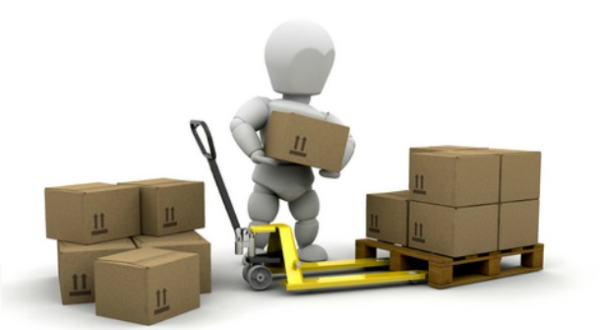 There are many things to consider when hiring a third party logistics company today. While the basics involve utilizing air, land, or sea transportation to move goods from one point to another, there are many intricacies that are added to the process in order to increase efficiency—both for the customer and the logistics company itself. With shifting trends and the notion of new logistics technologies being ever present, there are many concepts that are improving the way freight gets moved.
There are many things to consider when hiring a third party logistics company today. While the basics involve utilizing air, land, or sea transportation to move goods from one point to another, there are many intricacies that are added to the process in order to increase efficiency—both for the customer and the logistics company itself. With shifting trends and the notion of new logistics technologies being ever present, there are many concepts that are improving the way freight gets moved.
Overall, the most revolutionary changes that are happening in logistics technologies today are widely due to advances in mobile logistics technologies. In the past, there were only primitive ruggedized devices that were specifically put into use for supply chain environments. Now, the lines between consumer and commercial grade equipment are becoming blurred because of new logistics technologies. This provides customers, as well as professionals, with crucial solutions to improve processes in every step of the supply chain.
Technology and Logistics in the Warehouse
The utilization of mobile logistics technologies in the warehouse has completely changed the way that companies think about setting up, as well as sorting and segregating inventory. With a single smart phone, warehouse employees are now able to:
- View inventory counts remotely
- Scan inventory both short and long range
- Use voice activated commands to conduct operations hands free
- Send information through the cloud for instant results
- Track and trace transportation itineraries and transit times
Another warehouse trend that cloud-based logistics technologies have set is the use of complete mobile solutions. Because logistics technologies have spider-webbed into so many devices, warehouse teams can now use smart phones and tablets in combination with mobile printers. These scanning devices enable the warehouse workers to reduce the need to move back and forth to different stations in the warehouse. This eliminates issues with sorting, segregating, picking and packing, setting up RFID solutions, scanning barcodes and printing.
For the Customer
Mobile logistics technologies have made the customer end of logistics more productive than ever before. With app development at an all time high, the customer now has more information at their fingertips than ever before. These logistics technologies allow the customer to forgo contacting 3PLs directly in regards to queries such as:
- Inventory quantities
- Price quotes
- Real-time transit status updates
- Delivery times
- Confirmation of POD
Tracking has always been a huge issue for customers until recently because there was little information available without making hard inquiries by phone. But now, trucks, trains, ships, and planes can be outfitted with GPS trackers that the customer can dial into from their smart phone to see exactly where their freight is. This allows them to not only satisfy their curiosity, but plan accordingly based on suggested arrival times.
For the Driver
Utilizing the same type of logistics technologies, truck drivers can now perform many functions with far greater efficiency. Smart phones allow drivers to accurately capture customer signatures upon delivery, track their hours, and even examine statistics about their driving performance. GPS systems can also provide real time data about traffic situations so that they know about areas that should be avoided to achieve shorter transit times.
The Wave of the Future
The smart phone based logistics technologies available today are completely changing the way that everyone thinks about logistics. It is even paving the way for other advances in the future such as 3D printing and greater use of green solutions. For now, 3PLs and customers alike can enjoy the way that mobile logistics technologies has helped to improve the process overall.
STC Logistics utilizes the latest in technology for all logistics solutions. Contact us today to get a quote for your next shipment!
Photo credit: manufacturingdigital.com
The Impact of White Glove Service for Logistics Solutions
 There are many different types of freight being shipped every day across land, air, and sea channels. Some items tend to be far more fragile than others,thus require specialized attention in order to prevent an imminent disaster. The most ideal logistics solutions needed for cargo of the most delicate nature will come from carriers who embrace the concepts behind white glove service and understand its overall importance. As a result of such diligence, any business can feel secure knowing that their logistics affiliates are willing to take the time to carefully secure, handle and transport their cargo based on the unique physical attributes each shipment possesses, as well as the price tag of the items themselves and the time-sensitivity they require.
There are many different types of freight being shipped every day across land, air, and sea channels. Some items tend to be far more fragile than others,thus require specialized attention in order to prevent an imminent disaster. The most ideal logistics solutions needed for cargo of the most delicate nature will come from carriers who embrace the concepts behind white glove service and understand its overall importance. As a result of such diligence, any business can feel secure knowing that their logistics affiliates are willing to take the time to carefully secure, handle and transport their cargo based on the unique physical attributes each shipment possesses, as well as the price tag of the items themselves and the time-sensitivity they require.
Countering Potential Shipping Issues:
Just as different types of freight require different levels of hands on attention, each unique shipping method offers its own challenges regarding the way that freight must be handled. Fortunately, the use of white glove service presents a measurable counter for any potential threat that may or may not occur during all steps of the shipping process. Direct line-haul service can be used to minimize transfers, while special attention can be given to pick up and delivery methods. Transit times are reduced and your freight is tracked consistently to ensure on-time deliveries of your most time-sensitive cargo.
By Land:
When moving shipments by truck, some of the preventable dangers that can be experienced on the road include:
- Jostling of freight that could easily cause it to crack, break, or otherwise be damaged – remedied by packaging and securing the freight with the proper equipment
- The ever present threat of getting into an accident while on road – accidents occur, but timeliness in recovering from them is determinant in completing the job.
- Problems that could develop based on the temperature of the cab depending on the type of freight that is being shipped – temperature controlled equipment and temp tabs can regulate and monitor these issues
- Theft or vandalism that could easily happen while a truck is parked at any location – inventory tracking technology, secure cross-docking facilities, locked trucks and video monitored loading docks are some precautions taken to minimize theft
By Sea:
Problems that could be encountered by sea are somewhat similar and include:
- Waves from bad weather conditions that could easily cause the freight to be bounced around – contracting the correct size equipment and securing cargo is important in preventing slippage
- Long travel times that could cause time sensitive freight to expire – by knowing anticipated transit times and the nature of the product, your logistics company can lead you to choose the best service based on your type of freight.
- Temperature issues, especially if freight is being kept below deck – remedied just as any temperature sensitive situation
By Air:
The issues for freight moving by air are less serious, even though this is considered to be the safest means of transport:
- Jostling that could take place during take-off and landing – packaging practices are crucial
- Turbulence in the air – D-containers may be implemented to prevent moving inside the cargo space
The Solution:
Any business will find that logistics companies who pride themselves in offering white glove service can effectively combat each and every one of these issues. In doing so, such companies will assess if all items are neatly packed and secured with proper materials, all boxes are sealed correctly, delicate items are wrapped in the proper way, everything is loaded in the neatest order possible, and the correct type of shipping method used for particular types of freight. Packaging assessments should be made and solutions offered to your shippers so they can reinforce products prior to shipping. Without this level of service, there are too many potential disasters that could befall the freight in question which ultimately means lost time, lost money and unhappy customers.
By employing proper white glove service, logistics companies like STC Logistics are ensuring that those they work with will never have to fret in regards to even the most expensive or delicate types of freight. Because the top logistics outfits take their time to develop a unique solution, born in practices of white glove service and then custom tailor it for each and every item, it makes their service standards worth looking into. Because freight must ultimately be shipped in one manner or another, choosing the safest and most secure methods simply makes sense, which of course is precisely the aim of white glove service overall. Any company bold enough to embrace white glove service standards will be rewarded with personalized service, fewer pieces of damaged freight, faster shipping times, and happier customers overall.
To learn more about how you can safety ship the most delicate and high importance items from a trusted logistics provider, please click here.
New 3PL Technology Services Establish Flexibility and Reliability
 The biggest challenge with any 3PL provider is the ability to report up-to-date feedback on the status of a clients’ cargo. This challenge requires a strong element of control when dealing with time sensitive processes. It is crucial that a successful logistics plan is in place for any manufacturing or distribution establishment. According to a survey by Ernst and Young, more than 5% of all sales go to transportation. It is obvious that most organizations and businesses desire to have their customers served in the most efficient manner. This is where the latest technology practices come in to establish flexibility and reliability in logistics.
The biggest challenge with any 3PL provider is the ability to report up-to-date feedback on the status of a clients’ cargo. This challenge requires a strong element of control when dealing with time sensitive processes. It is crucial that a successful logistics plan is in place for any manufacturing or distribution establishment. According to a survey by Ernst and Young, more than 5% of all sales go to transportation. It is obvious that most organizations and businesses desire to have their customers served in the most efficient manner. This is where the latest technology practices come in to establish flexibility and reliability in logistics.
3PL Technology Removes Complexity
In order to instill the right confidence in a transportation transaction, 3PL providers integrate new technology for capturing and analyzing data points along the supply chain. These data points include updates on preparation and planning, cargo dimensions, customer-specific instructions, packaging/handling, restrictions and destinations. All this information needs to be coordinated in order to track, trace and control the movement of cargo within a specified time frame. Without using new technology, this can be challenging to manage, especially since each cargo requirement is unique.
3PL Technology Integrates with Customer Processes
The value of the new technology that 3PL’s provide is very useful to the customer when they can relate it to their priorities. Many customers desire having the option to check up on cargo status as well as being able to specify times and dates for collection, storage and delivery. Most cargo deliveries are quite sensitive to the degree of where specific ambient conditions are specified and bound within a specific delivery time. Advanced 3PL companies present an integrated way of interacting with a system. Many allow their customers to interact with their orders in a real-time fashion which offers control over the period, the condition and the handling requirements for their cargo. This integrated approach presents the 3PL company as a reliable service that is respondent to a customer’s specific needs on demand. In turn this allows the 3PL to understand the dynamic needs of each client to ensure quality, service satisfaction and efficiency.
Value Added Features
It is reassuring when customers know the status of the cargo. In terms of location, expected time of arrival, status and condition, it is crucial for business to run smoothly. This information gives clients a confidence of service reliability since the 3PL company is committing to the customer service process. From the 3PL perspective, things might look a little hectic in meeting this requirement, but the best companies have adopted the following accurate practices:
- Monitoring the cargo through time-stamped status updates which reflect the condition and location of the cargo. Tracking information is relayed directly to the customer portal where it is reflected as real-time information.
- Tracing the whereabouts of cargo in the event that the delivery instructions change or there are unavoidable circumstances that would prevent timely delivery of the cargo. This is typically monitored internally and serves as a tool to pin-point cargo.
- Implementing a logistics plan allows for management and structure of the cargo. This ensures that odd-sized or delicate goods get specialized attention, that handling precaution has been made and that the cargo is moving by means of adequate transportation services.
Determining and Managing Transportation Methods
Premier 3PL companies use many methods of transportation; whether by sea, rail, road or air, their clients’ products, priorities and constraints are central to accomplishing a common goal. These methods allow 3PL’s the flexibility to respond quickly to time or budget critical orders. In order to serve all customers with integrated equal maintenance, accessibility to new technology practices is essential in allowing customers to plan effectively. The use of advanced technology allows all transportation schedules and parameters to be joined into one common operating system.
STC Logistics utilizes and offers to their clients, the most up-to-date technology programs and practices. Learn more about our shipping process by clicking here.
Retail Display Environments: The Role Logistics Play
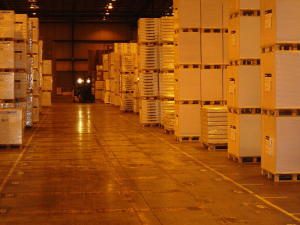 Achieving success in retail display environments depends on various factors. Every retailer must have an exceptional logistics system in order to offer the best quality service to their customers. Logistics play a major role in sourcing and inventory management, among other key activities in the overall supply chain. A retailer should provide customers with products they desire at the correct quantities, the correct time, and the correct place. In order for a retailer to successfully carry out these activities they require a logistics provider who demonstrates sufficient experience and one that is staffed with experts who can solve any complex transportation issues as they arise. Along with offering the best competitive prices, maintaining standards of service are important when implementing the correct mode of transportation and are a key focus of a knowledgeable logistics team. Here are some of the reasons why logistics are important to every retail display environment.
Achieving success in retail display environments depends on various factors. Every retailer must have an exceptional logistics system in order to offer the best quality service to their customers. Logistics play a major role in sourcing and inventory management, among other key activities in the overall supply chain. A retailer should provide customers with products they desire at the correct quantities, the correct time, and the correct place. In order for a retailer to successfully carry out these activities they require a logistics provider who demonstrates sufficient experience and one that is staffed with experts who can solve any complex transportation issues as they arise. Along with offering the best competitive prices, maintaining standards of service are important when implementing the correct mode of transportation and are a key focus of a knowledgeable logistics team. Here are some of the reasons why logistics are important to every retail display environment.
Logistics allows the retailer to concentrate on other core activities
For a retail business to produce successful results, the company must be able to spend a substantial amount of time focusing on the management of their company. Too much time spent on dealing with their logistics efforts denies their staff the ample time they need to concentrate on other key activities; such as marketing, administration, customer care or inventory management. It is important that a retailer chooses a reliable logistics provider that is experienced and cohesive. This way, it is possible for management to give attention to other activities that are core to the retail environment.
Logistics increase retail efficiency
The most critical requirement of every retailer is having the ability to offer products at the right place and at the right time. With a good logistics provider, an eye-catching flow of goods will be displayed in and out of the store. Having a reliable relationship with your chosen 3PL will allow for last minute changes and a working relationship that allows you to be confident in your transportation decisions. This means that your company rarely suffers from unexpected damages or delays that can cause negative impact on both the business and the customers. However, it is important that you implement good store management techniques to avoid losses associated with poor stock management. Make sure that the various stock levels are communicated to your supply at the right times. If last minute rush orders are necessary, have a logistics team behind you to accommodate those requests. This will not only strengthen your total supply chain, but may go a long way in helping to avoid losing potential customers.
Transport expenses are passed to a third party
There are many overhead expenses that are included in the transportation of products. In addition to clearing and forwarding in the case of imported products being moved, you may have extra expenses that you haven’t budgeted for. This could become very expensive for a retail business. Teaming up with a dependable logistics provider who offers insight and risk assessment will allow you to minimize these expenses as well as other transport risks. Pre-planning is key in maintaining your budgets.
Goods in transit are stored goods
When goods are being transported from one location to the other, there are considered to be stored goods. A good logistics provider will allow your company to avoid extra storage costs until the goods arrive safely at the retailer of choice. Make certain to negotiate storage fees upfront and get to know you 3PL’s policies on timeframes.
Using a trustworthy logistics provider is influential on the amount of success resonated in retail display environments. Your 3PL should be aware that the primary role of the retailer is to offer products to customers on-time and undamaged and at reasonable prices. A reliable logistics provider like STC Logistics can help customers have more time to focus on proper retail management of their company by managing the behind-the-scenes transportation effort that goes into a successful retail campaign. In turn this will help increase the amount of retail efficiency within the company. STC Logistics can also assist in pre-planning your shipping schedules and accommodating budgets, while maintaining the highest level of service. They will work to cover extra storage expenses that typically aren’t covered by other logistics providers and give you a clear picture, upfront, of what costs may be incurred through different modes of transportation. Learn more about our adding STC to your team at: https://shipstc.com/domestic-transportation.html
4 Ways to Strengthen Your Supply Chain
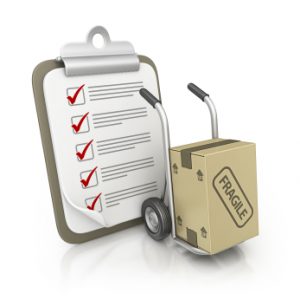 Companies strive to minimize transport costs and maximize the ability to meet the needs of their clients to achieve success in their business. The most crucial step in this process is to execute an effective supply chain management system. This involves managing products to be transported, ensuring the correct method of transportation is used and establishing the most cost-effective route between the origin and the destination. These factors determine your capacity to derive value from using a supply chain management system.
Companies strive to minimize transport costs and maximize the ability to meet the needs of their clients to achieve success in their business. The most crucial step in this process is to execute an effective supply chain management system. This involves managing products to be transported, ensuring the correct method of transportation is used and establishing the most cost-effective route between the origin and the destination. These factors determine your capacity to derive value from using a supply chain management system.
In any good system, you ought to be able to measure performance and execution; otherwise you will not be able to assess whether value has increased or decreased in your company. Benchmarks are set to determine the acceptable limits of performance pertaining to different business environments. Try to follow these four guidelines to ensure your supply chain is operating smoothly:
Don’t Delay Your Delivery
Any company that implements supply chain management typically guarantees reliable delivery of raw materials and finished goods through use of a bid, which outlines job parameters and expectations upfront. This involves a close working relationship with suppliers, customers, shippers and warehouses. If any of these parties fail to perform their role on time, it is likely that the entire process will be delayed, resulting in direct consequences on all the parties involved. Establish your deadlines early on and monitor production schedules to ensure a reduction in delays.
Keep Strong Relationships
Another fundamental component in having an effective supply chain is to have lasting relations with suppliers and customers. This means you should have stable prices available. The inability to guarantee stable prices for a final product is typically associated with an increased cost of doing business, increased material costs and the transportation necessity. This can make it impossible to maintain product prices. You should detail the factors that cause such internal and external price fluctuations. Include these factors before a final price is set and take them into account when developing ideas and negotiating deals.
Break Down Your Information
In an effort to guarantee a seamless supply of raw materials and finished goods, companies enter into agreements with stakeholders to deliver different types of cargo on specified dates or at certain inventory levels. This eliminates the need to recurrently place orders for such goods, which also removes incidents of stock-outs and subsequent lost sales. However, there are times when the suppliers may deliver goods at the wrong time or place, or deliver entirely the wrong goods. This is a failure of coordination in the supply chain and can have devastating effects. Pre-planning schedules and offering verification checks can help to diminish stock-outs or production of poor quality goods due to use of improper inputs.
Streamline Your Technology
Any manufacturing company that desires to have an efficient supply chain must monitor various production costs to guarantee that they remain within manageable limits. This can involve integrating systems, with your chosen 3PL. Doing so can provide for optimal inventory levels, ensure orders are processed quickly and accurately, tracking is internally transparent, and back office accounting is streamlined. A reliable logistics service provider can help to minimize delays and damages, which are other key outlays in supply chain. Switching transport responsibilities between providers often involves a change in processes, therefore integrating with a technology driven partner can save time and money year over year. By streamlining your supply chain management through the help of a dependable shipping partner and cohesive technology, you can stay one step ahead of the competition.
Every company should strive to take these tips into consideration to demonstrate a reliable supply chain that integrates various stakeholders and resources to guarantee the quality, price and reliability of the entire system. If a firm overlooks negative signs that show inefficiencies in such systems, there is high likelihood that these systems may fail in the long run. Automation paired with having a fully-fledged supply chain department can help manage the supply chain effectively, and in turn, success should shine through in your business.
Top Four Reasons to Partner with a 3PL
A third party logistics provider (3PL) offers outsourced or third party logistics services for part of or all necessary supply chain management operations. 3PL’s typically specialize in warehousing and transportation needs that can be customized to a customer’s requirements. As a business decision maker, there are many benefits to partnering with a 3PL.

Did you know that over 82% of Fortune 500 companies partner with at least one 3PL? Here are the top four reasons why:
- Peace of Mind: Knowing that you have a professional partner on your side to manage the transportation of your goods will allow you to focus on other operations. Look for a 3PL with years of experience, professional service and the resources to get your items from point A to point B on time and undamaged.
- Risk Reduction: If you choose transportation carriers on your own, it can be easy to overlook important factors such as operating authorities, insurance information and safety ratings. Utilizing a 3PL ensures that you won’t put your freight in the hands of an incompetent carrier. STC standards of excellence and rating systems are imposed to safeguard against ineffectiveness.
- Time is Money: Do you really have the time to route, track and manage day-to-day issues that arise from your freight? Many little issues can arise in logistics and 3PL providers have dealt with it all. Electronic transfers of data can minimize inaccuracies and provide real-time updates throughout the duration of your shipment.
- Speaking of Money… 3PL providers have an eye for logistics. They can arrange your freight, consolidate LTL shipments and recommend unique solutions that you may not have thought of before. Having the ability to find a different, yet better way to ship your products is a valuable asset that a 3PL can offer. Look for a provider that can provide assistance for your unique freight shipments.
STC Logistics has industry expertise and a reputation for quality. We provide expert consultation and have relationships with a vast network of nationwide secure cross-docking facilities. If you are considering hiring a 3PL company, you should analyze some key areas of your shipment needs to determine what your logistics partner should provide. Download the free resource, “Hiring a Third Party Logistics Company,” by clicking here.
